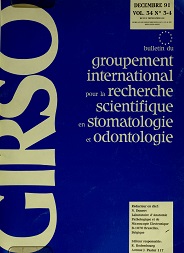Microradiographic and histologie study in a case of dentinogenesis imperfecta Type I
Keywords:
dentinogenesis imperfecta Type I, calcification, dentin, pulpAbstract
Four temporary teeth, extracted for periodontal infection reasons, from a 53 months old child with Osteogenesis Imperfecta, have been coated in methyl metacrylate and prepared for microradiographic analysis and light microscopic study.
The enamel and dentin of three teeth (51, 65 and 85) don’t show any particularity, some how the cementum is remarkably thin. Pulp chambers was large and contain a great number of calcifications. Some of them present a radial striation around a radio-transparent center, and when coloured with blue of methylen, they revealed inflammatory or fibroblastic cells.
The fourth tooth (55) shows a dentinogenetic overproduction which closed the major part of the pulp chamber. The dentin presents two rows of different aspect, separated with a calcified bond. The mantle dentin contains sinuous tubules with a type I arrangement of SIAR classification (1986). But, in the deepest dentin, they are very little size and joined together while approching the center of the tooth and coast along cellular inclusions, pathognomonical sign of Dentinogenesis Imperfecta. The pulpal space not oblitered contains a calcification with radial and microlacunary aspect.
So the dental disturbance is shown variably in the teeth 55 and 65 with contemporaneous formation. In the other way, intrapulpal calcifications in Dentinogenesis Imperfecta, are not only prerogative of non oblitered pulp.
Downloads
Published
Issue
Section
License
I hereby certify that the authors of the above manuscript have all:
1. Conceived, planned, and performed the work leading to the report, or interpreted the evidence presented, or both;
2. Written the report or reviewed successive versions and shared in their revisions; and
3. Approved the final version.
Further, I certify that:
1. This work has not been published elsewhere and is not under revision in another journal;
2. Humane procedures have been followed in the treatment of experimental animals (if applicable);
3. Investigations in humans was done in accordance with the ethical standards of the responsible committee on human experimentation or with the Helsinki Declaration (if applicable).
4. This paper has been carefully read by a native English speaker who is familiar with the field of work (this applies to authors who are not fluent in English); and
5. The copyright of the article is transferred from the authors to the Bulletin du Groupement International pour la Recherche Scientifique en Stomatologie et Odontologie upon acceptance of the manuscript.



